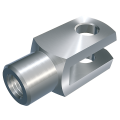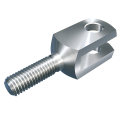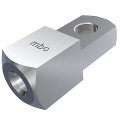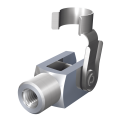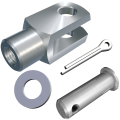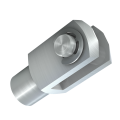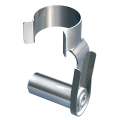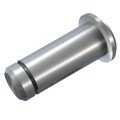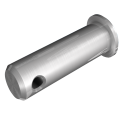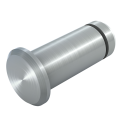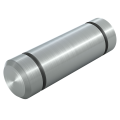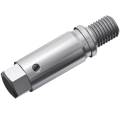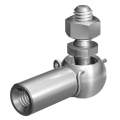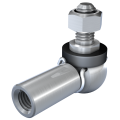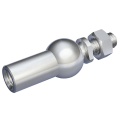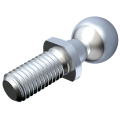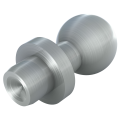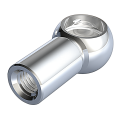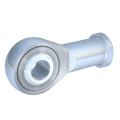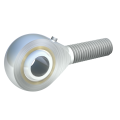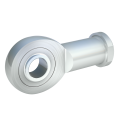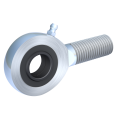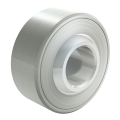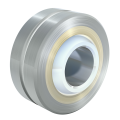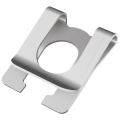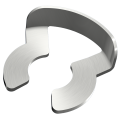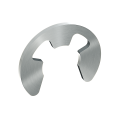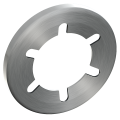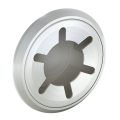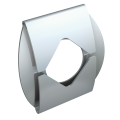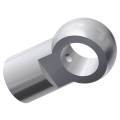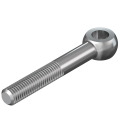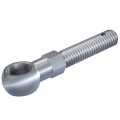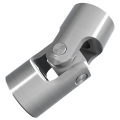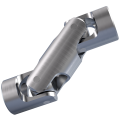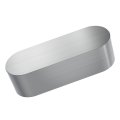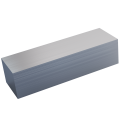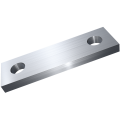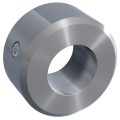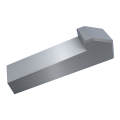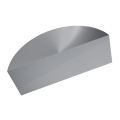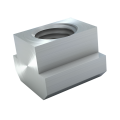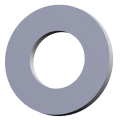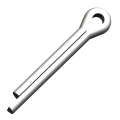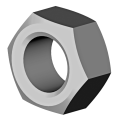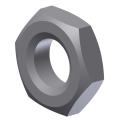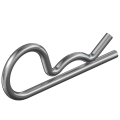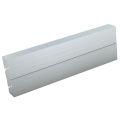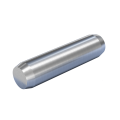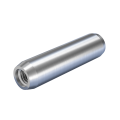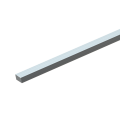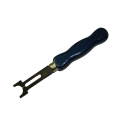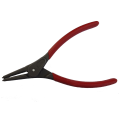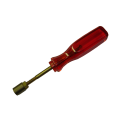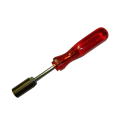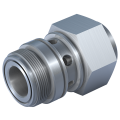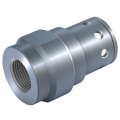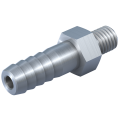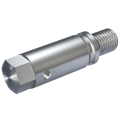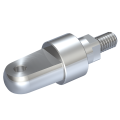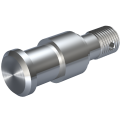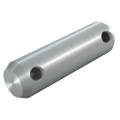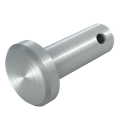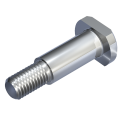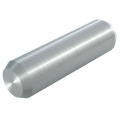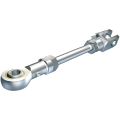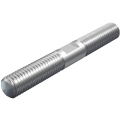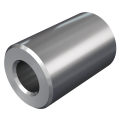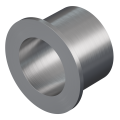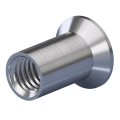1. Product description
High-Performance Components for dynamic applications
Rod ends according to DIN ISO 12240-4 (DIN 648), also known as joint rod ends or rod bearings, are mechanical linking elements designed for precise motion control in various applications. They allow for angular mobility in multiple directions, meaning they can permit rotary or pivoting movements around different axes. This makes them especially useful for transmitting static and dynamic forces while allowing the connected element freedom of movement. These ready-to-install machine elements are particularly suited for applications with low sliding speeds.
The standard DIN ISO 12240-4 (DIN 648) defines the dimensions, tolerances, load values, and other important specifications for rod ends to ensure uniform quality and interoperability of these essential mechanical components. Standardization ensures that rod ends from different manufacturers are compatible with each other and can be used in a wide variety of applications without the need for specific adjustments.
The construction of a rod end consists of three perfectly matched components:
- Internal Ring
- Housing
- Bearing shell
Thanks to a cleverly chosen construction and material mix of the individual components, the fasteners can be used under axial load, high pressure, tensile and compressive loads, higher rotational speeds, or high dynamic load. And this applies to both steel and stainless steel material pairings.
For maintenance-free versions, high-performance sliding films (e.g., made of PTFE) are bonded on the inside of the bearing shell as a sliding layer. This ensures a permanent use of the rod end. Due to the high variety of options and the resulting properties, the standardized rod ends can be found in almost all industrial applications.
Both K series and the narrower E series are available, each with female or male threads. Alternatively, these rod ends are available in maintenance-free versions or can be regreased (needs maintenance).
This makes rod ends available for a wide range of loads and applications:
K series
Rod ends suitable for dynamic loads
Rod ends suitable for high dynamic pressure loads and tensile forces
Rod ends suitable for high dynamic pressure loads and tensile forces - corrosion resistant
Rod ends suitable for low axial forces and for low swivelling movements, unsuitable for complete revolutions (without bearing shell)
Rod ends suitable for axial thrusts
Rod ends suitable for higher rotation speeds
Rod ends suitable for high pressure loads and tensile forces
Rod ends suitable for higher rotation speeds - corrosion resistant
Rod ends suitable for high unidirectional thrust loads, application only for low swivelling movements, unsuitable for complete revolutions (without bearing shell)
Rust-resistant corrosion-resistant series
Series with sealing
Series with threaded bolt
Rod ends with CETOP connection thread for pneumatic cylinders
E series
Rod end suitable for high unidirectional loads
Rod end suitable for high unidirectional loads – corrosion resistant
Rod end suitable for high alternating loads
2. Product details
Size: 5 M4 – 50 M48FG
Material group: steel, stainless steel, stainless steel A4 quality
Surface: galvanized
Thread version: fine-pitsch thread right, regular thread right + left
Thread size (d3): M2 x 0.4 – M64 x 4 FG
Size:
Selecting the correct size of a rod end according to DIN ISO 12240-4 (DIN 648) is essential for the performance, durability, and safety in mechanical connection systems. It must be compatible with adjacent components to enable proper assembly and integration into the overall system. The sizing affects not only the physical fit but also the ability of the components to work properly together. The size of the rod end also determines its load capacity. An undersized rod end can deform under load, fail, or lead to premature system failure. On the other hand, a correctly sized rod end ensures that the expected loads can be handled safely. Rod ends allow rotational and tilting movements. The size of the rod end must be chosen to ensure the necessary freedom of movement and precision for the respective application. Too large or too small rod ends can impair movement efficiency and lead to inaccurate results.
Thread:
The thread allows the rod end to be securely and firmly attached to a threaded rod or similar fastener. This method of connection is robust, durable, and ensures that the rod end remains stable under load or motion. Additionally, it offers the possibility of fine-tuning the positioning. Rod ends are available with both female and male threads.
By turning the rod end along the thread, one can adjust the length or tension of the connection, which is particularly advantageous in precision applications. This adjustability facilitates optimizing system performance and aligning to specific requirements.
Furthermore, it simplifies the assembly and disassembly process of rod ends, as no special tools or procedures are necessary.
This makes maintenance, repairs, and part replacements easier, reducing operating costs and downtime.
Thread Type:
For rod ends according to DIN ISO 12240-4 (DIN 648), as well as other threaded components, a distinction can essentially be made between regular threads (coarse threads) and fine-pitch threads. Regular threads on rod ends are characterized by a relatively large pitch, enabling quick screwing and unscrewing and are used in general applications where acceptable load capacity is sufficient. Fine-pitch threads, on the other hand, have a smaller pitch, offering finer adjustability, higher load capacity, and better vibration resistance, making them preferred in precision-critical applications.
The components are available with right-hand and left-hand threads.
For applications on pneumatic cylinders, there are rod end series with female threads with the suitable CETOP connection dimensions.
While regular threads offer good strength against loads and higher tolerances, fine-pitch threads provide better load distribution and are ideal for applications requiring high precision. The choice between regular and fine-pitch threads depends on the specific requirements of the application, including the needed adjustability, load capacity, and precision. Fine-pitch threads are particularly well-suited for applications with high dynamic loads and where vibrations may occur, while regular threads are suitable for more general fastening tasks.
Thread size:
The thread size for rod ends according to DIN ISO 12240-4 (DIN 648) is a crucial feature that pertains to the dimension and profile of the thread used to attach rod ends to rods, shafts, or other mounting points. The thread size determines compatibility with other components and affects the load capacity, adjustability, and application possibilities of the respective rod end. The standardization of thread sizes enables easy selection and interchangeability of components within mechanical systems.
The range goes from thread size M2 to M64.
Series:
The standard DIN ISO 12240-4 (DIN 648) for rod ends defines various series that establish the dimensions and tolerances of the rod ends.
Two important series within this standard are E Series and K Series. These series differ in their dimensions and areas of application and are each designed for specific load requirements.
The E Series is also known as the small series.
Maintenance Type:
In the standard DIN ISO 12240-4 (DIN 648) for rod ends, two types of maintenance are typically distinguished: needs maintenance and maintenance-free rod ends. This categorization is based on the need for regular lubrication and maintenance to ensure long-term safe and efficient operation.
Rod ends needs maintenance are designed to be lubricated at regular intervals to ensure proper functioning and longevity. These rod ends typically have lubrication channels and openings called grease nipples, through which lubricants can be introduced into the bearing. Regular lubrication helps to reduce friction and wear and protects against corrosion. Maintenance-required rod ends are often used in harsh environments or under high loads, where regular maintenance is essential to maintain operational capability.
Maintenance-free rod ends, on the other hand, are designed so that they do not require additional lubrication throughout the product’s lifespan. They typically contain self-lubricating materials or a special bearing design that eliminates the need for external lubrication. This type of rod end offers a practical solution for applications where regular maintenance is difficult or undesirable. Maintenance-free rod ends are ideal for hard-to-reach installation sites or for applications with relatively low movement frequencies and loads.
Material group:
Rod ends according to DIN ISO 12240-4 (DIN 648) can be made from various materials, with steel, stainless steel, and stainless steel A4 quality being the most common options. Each of these materials comes with specific advantages, making them suitable for different applications and environmental conditions.
The choice of material for rod ends should be based on the specific requirements of the application environment and the desired properties. While steel offers high strength at low cost, stainless steel and particularly stainless steel A4 quality are suitable for applications that require higher corrosion resistance. Each material has its own advantages, making it ideal for certain industrial or environmental-specific requirements.
Static basic load rating:
The static basic load rating C0 (kN) -see Product details- refers to the value at which a rod end can be stressed at the weakest cross-section under a non-moving load without permanently deforming. This value represents the permissible radial bearing load when stationary. The specified load ratings are calculated based on the respective material properties and verified through tensile tests at room temperature. The yield strength has been utilized up to 80%. Therefore, the safety factor to the onset of yielding is 1.25.
The permissible axial load is also calculated based on the static load rating:
Fa = Fa perm. = p • C0 (kN)
p = < / ~ 0.2 for rod ends K series maintenance-free version
Dynamic basic load ratings for rod ends are available on request.
Speed:
The speed for rod ends according to DIN ISO 12240-4 (DIN 648) is an important parameter that indicates how fast the rod end can rotate relative to its holder or the connected element without causing excessive wear or reducing the lifespan of the rod end. This specification is particularly relevant for applications where the rod ends are exposed to rotating or oscillating movements. A higher allowable speed means that the rod end is suitable for applications requiring rapid movements. This has a direct impact on the performance and efficiency of the entire construction or machine. The design and material of the rod end, including the lubricants used and the condition of the sliding surfaces, are crucial factors determining its maximum allowable speed. Maintenance-free rod ends with self-lubricating materials may have lower speeds compared to those that require maintenance, as their lubrication capacity is limited. The optimal function and lifespan of rod ends thus depend on a tailored selection according to the required speed and operating conditions.
Temperature:
The temperature resistance of rod ends according to DIN ISO 12240-4 (DIN 648) refers to the range of minimum and maximum temperatures within which the rod end can be used without impairing its function or significantly reducing its service life. This resistance is particularly relevant for applications where the rod ends are exposed to extreme temperatures or widely fluctuating temperature conditions.
We offer rod ends with a temperature resistance range of -150°C to +250°C. Exact specifications can be found in the respective product information.
Threaded bolt:
Threaded bolts are an option for the fastening and connection of rod ends according to DIN ISO 12240-4 (DIN 648) and support precise and flexible connection with other components. In this variant, the threaded bolt is already securely attached to the inner ring and is ready for installation for the desired 'right-angle' connection.
Rod ends with threaded bolts facilitate the mechanical connection for certain installation situations and enable the transmission of forces and movements within the construction. At the same time, they offer the possibility to fine-tune the position and orientation of the rod ends, which is particularly useful for complex assembly requirements. The ease of mounting and dismounting is another advantage that simplifies maintenance work and the replacement of components. Thanks to the optional use in almost all standard versions, the rod end with threaded bolt is available in various sizes and thread types, thus supporting effective load transmission in 'right-angle' applications to achieve optimal results.
Sealing:
A sealing on rod ends according to DIN ISO 12240-4 (DIN 648) serves the purpose of preventing the ingress of foreign particles, dirt, and moisture into the pivoting bearing, thus protecting the internal components such as the bearing shell and inner ring. This protective measure significantly contributes to the longevity and functionality of the rod end by minimizing friction and wear, thereby enhancing the reliability and performance of the entire structure. Additionally, the sealing retains lubricants within the bearing, ensuring enduring and low-friction movement between the moving parts. This is particularly important in harsh environments or applications subjected to high exposure to dust, dirt, or moisture, to extend maintenance intervals and ensure operational safety.
Optionally, many variants of rod ends can be delivered with sealing.
Clevis compatibility:
Clevises and rod ends according to DIN ISO 12240-4 (DIN 648) can form an adjustable, movable connection, as the spherical part of the rod end from the E series fits into the U-shaped opening of the clevis. A bolt or cotter pin inserted through both components creates a secure yet flexible connection that allows movement in multiple directions. This configuration enables efficient transfer of forces between the connected parts while remaining adaptable for angle corrections or variable alignments. This collaboration is crucial for applications requiring precise motion control and load transfer under varying angles.
Material combinations:
DIN ISO 12240-4 (DIN 648) for rod ends defines various designs and material combinations for bearing pairs to ensure their applicability under a variety of operating conditions. The different material combinations of the bearing pairs are determined by the requirements for load capacity, maintenance-free operation, and the operating environment.
Here are the most common combinations
Steel/Steel Bearing: This combination is used in demanding applications due to its high load capacity and robustness, where high loads and impacts occur. Steel/Steel bearings require regular lubrication to minimize friction and extend their lifespan.
Steel/Bronze: The steel/bronze combination is often used in applications requiring high load capacity and heat resistance. Bronze bearings can operate with lubricants to improve sliding properties and increase wear resistance.
Steel/PTFE (Polytetrafluoroethylene, maintenance-free): PTFE-coated or PTFE-filament wrapped bearing surfaces offer extremely low friction and are generally maintenance-free. They are resistant to a wide range of temperatures and chemicals, making them ideal for high-performance applications in various environments.
Choosing the right material combination is crucial for the performance of the rod end and heavily depends on the specific application conditions, including the load, movement frequency, environmental conditions, and the need for maintenance-free operation.
3. Application Areas & Compatibility
Mechanical and plant engineering: In mechanical and plant engineering, rod ends are used for precise guidance and positioning of mechanical components. They allow for the compensation of angular misalignment and are indispensable in movable connections, such as those found in production lines, conveyor systems, or machine tools. Their robustness and durability ensure smooth operation under high loads and in demanding environments.
Automation: Rod ends are essential elements in automation, ensuring smooth and precise motion sequences. Their adaptability to changing loads and high tilting and rotational frequencies make them a reliable component for long service life. Thus, rod ends according to DIN ISO 12240-4 (DIN 648) significantly contribute to the performance, safety, and reliability of mechanical systems in automation technology. Their standardized quality and interchangeability simplify planning, installation, and maintenance in various application areas.
Construction machinery and construction vehicles: In the construction machinery and vehicle industry, rod ends according to DIN 648 play a fundamental role in the performance and reliability of equipment. They are used at critical connection points, such as in the control of excavator arms or steering systems. The ability of rod ends to withstand high loads under harsh environmental conditions while allowing precise movements is crucial for efficiency and safety on construction sites. Their robustness ensures reliable functionality even in dusty, wet, and mechanically demanding conditions, extending maintenance intervals and optimizing the readiness of construction machinery and vehicles.
Shipbuilding: In shipbuilding, rod ends are critical components in steering and suspension systems. They contribute to the stability and maneuverability of ships by allowing complex movements and power transmissions between different ship components. Their resistance to corrosive seawater conditions makes them particularly valuable in this industry.
Medical technology: In medical technology, rod ends are valued for their precision and reliability. They are used in medical devices and equipment, for example, in motion guidance systems for therapy and rehabilitation devices. The requirements for hygiene and accuracy in medical technology are reflected in the specific material and processing properties of rod ends.
4. Advantages and Benefits
The use of rod ends according to DIN ISO 12240-4 (DIN 648) offers a range of advantages and benefits for various industrial and technical applications:
High precision and reliability: Rod ends enable precise motion control and ensure reliable power transmission, even under conditions where compensating for angular misalignment is required.
Angular mobility in multiple directions: The design of the rod ends allows rotational and pivoting movements around different axes, supporting versatile applications in dynamic systems.
Easy installation and high interchangeability: Due to the standardization of dimensions, tolerances, and load values according to DIN ISO 12240-4 (DIN 648), compatibility with different systems is ensured, simplifying installation and replacement.
Long lifespan under difficult operating conditions: The robust construction and the option to choose from various material combinations for the bearing pair contribute to rod ends having a long lifespan even under demanding conditions.
Enhanced efficiency and safety: The precise and reliable function of the rod ends supports effective performance of mechanical systems, increases operational safety, and contributes to the reduction of maintenance costs.
Maintenance-free and needs maintenance variants: Rod ends are available in maintenance-free versions, which allow permanent operational readiness without additional lubrication, as well as in maintenance-required variants that require regular lubrication to ensure optimal functionality.
Suitability for various applications: From mechanical and plant engineering to construction machinery, shipbuilding, medical technology, and robotics – rod ends according to DIN 648 are used across industries due to their versatile properties and advantages.
5. Rod end configurator
Over the years, a variety of standard versions have been established within the rod ends according to DIN ISO 12240-4 (DIN 648). These vary in structure, function, load capacity, corrosion resistance, and maintenance intensity.
To safely and quickly find the application-related desired part, the rod end configurator was developed.
Within seconds, the suitable component is determined by entering the desired parameters, and all relevant details such as product specifications, 3D model, dimensional sketch, availability, price, and delivery time are available in real-time.
It doesn't get faster, more transparent, or more reliable for rod ends according to DIN ISO 12240-4 (DIN 648)!
Thanks to our unique rod end configurator, you can filter the following properties to quickly and easily find the right rod end:
|
· Size |
· Thread |
· Thread version |
· Thread size |
|
· Series |
· Maintenance |
· Material group |
· Static basic load rating |
|
· Number of revolutions |
· Temperature |
· Threaded bolt |
· Sealing |
|
· Clevis compatibility |
|
|
|
If the configurator does not offer the desired rod end, we are of course available for customized special solutions.
6. Assembly and Installation
Preparation:
- Compatibility: Ensure that the connection components (e.g., shafts, rods) are compatible with the specifications of the rod end.
- Cleaning: Clean the contact surfaces on the rod end and connection components to ensure an optimal connection.
- Inspection: Check the rod ends for damage or manufacturing defects before assembly.
Assembly:
- Positioning: Position the rod end so that the fastening elements (e.g., bolts, pins) can be inserted smoothly.
- Fastening: Insert the fastening elements and secure them accordingly. Observe the recommended tightening torque.
- Alignment: Ensure that the rod end is correctly aligned to avoid misloads or premature failure.
- Lubrication: For maintenance-required models, perform the necessary lubrication before commissioning.
Final Inspection:
- Check all connections for tightness and correct assembly.
- Inspect the freedom of movement and function of the rod end.
Documentation:
- Document the assembly and any special features for maintenance and inspection purposes.
7. Safety instructions
- Use of correct tools: Only use appropriate and intact tools for assembly and disassembly to avoid damage to the rod end and injuries.
- Proper handling and storage: Rod ends should be handled carefully and stored properly to prevent mechanical damage and corrosion.
- Inspection before installation: Check rod ends for possible transport or storage damage and material defects before installation. Do not install defective parts.
- Adherence to maximum load limits: Never exceed the load limits specified by the manufacturer to avoid overload damage and potential accidents.
- Avoiding misalignments: Ensure that the rod end and attached components are correctly aligned to prevent uneven wear or premature failures.
- Regular inspection and maintenance: Conduct regular inspections of rod ends for wear and damage. Maintain serviceable models by timely and regular lubrication.
- Pre-operation inspection: For serviceable models, ensure proper lubrication before putting them into operation.
By following these safety instructions, you help to ensure the safe handling of rod ends according to DIN ISO 12240-4 (DIN 648) and minimize the risk of accidents and failures in your applications.
Frequently Asked Questions (FAQ)
What is meant by rod ends according to DIN ISO 12240-4 (DIN 648)?
How is the structure of a rod end designed?
How does the DIN ISO 12240-4 (DIN 648) standard contribute to the efficiency of rod ends?
How does the size of a rod end according to DIN ISO 12240-4 (DIN 648) affect its performance?
For which applications can rod ends be used?
In which industries can you find standardized rod ends?
What types of maintenance are available for rod ends?
What are the benefits of maintenance-free rod ends?
What distinguishes regular threads from fine-pitch threads in rod ends?
What special variants of rod ends are offered for hydraulic applications?
What does the static basic load rating C0 mean for rod ends?
How is the permissible axial load of a rod end calculated?
What are the advantages of using rod ends in mechanical systems?
What are the advantages of the modular system in the production of rod ends?
What are the advantages of the mbo Osswald rod end configurator?
What are the options for standard rod ends?
Does mbo Osswald also offer rod ends with CETOP connection dimensions?
Are special parts possible?
Fast-track this part (max. 400 units) through our production facility. Shorten the delivery time by 1-2 working days. We are currently exclusively testing this delivery service for Germany.
incl. VAT
plus shipping costs

